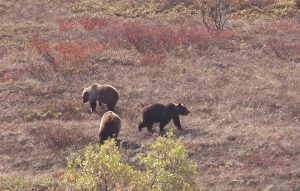One Last Cast
From Alaska Outdoors Radio Magazine
By Evan Swensen
Chapter Fourty
Hiking and Wildlife

In the early 1970s, there was a renewed interest in placer gold exploration and mining in the Nelchina area and the old trails north of Sheep Mountain were used again. Early users of the Chickaloon-Knik-Nelchina Trail began their trek at Knik on the north shore of Knik Arm of Cook Inlet. Civilization, towns, farms, roads, and highways have replaced or covered the old trail. Hikers now access this historical trail at the Chickaloon Trailhead, other trailheads along the Glenn Highway, or Old Man Creek Trailhead, the trail’s most northern access point.
This whole area is crisscrossed with animal and human trails that would fill a book if only a brief description were used for each trail. I’ve lived in Alaska and walked these trails for more than three decades, and I’m still discovering new paths and places to visit and new ways to get there.
Once while hiking one of the old trails, I met a young couple and asked how they liked the trail. They said they had enjoyed the rich abundance of wildflowers but had hoped to see wildlife.
I told them most wildlife bedded down during the day and were out feeding in early morning and late afternoon.
I suggested they take a nap and hike the trail again in the early morning or late evening, bring binoculars, stop in open areas, and they would probably see fox, caribou, and moose. When I talked to them next, they were hooked on Alaska and her “wildlife everywhere.”
One spring, my 15-year-old daughter, Diane, and I spent two days and one night on Sheep Mountain observing and photographing a band of Dall rams.
Sheep have excellent eyesight and can pick up the slightest movement if people allow themselves to be seen. Once seen, however, don’t move out of sight.
As soon as sheep cannot see the person they have been looking at, they will quickly move away. We watched our sheep for an hour or more, and they did not move. I told Diane about sheep running if they saw us, then couldn’t see us. She decided to test the theory. As soon as she moved out of sight, the four big rams quickly stood up and walked over the hill and out of sight.
Alaska’s not “full of wildlife,” as some brochures want you to believe, but there’s plenty. It’s called wildlife because it’s wild. Wild animals have habits peculiar to the species and season. If hikers want to add wildlife to the joy of the hike, they must know wildlife and hike with the practices and patterns of wildlife in mind.


